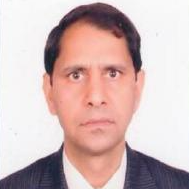
Satish Chand
Work place: Department of Computer Engineering, Netaji Subhas Institute of Technology, New Delhi, India
E-mail: schand86@hotmail.com
Website: https://www.researchgate.net/profile/Satish-Chand
Research Interests: Video Processing, Video Broadcasting, Digital Watermarking, Digital Steganography, Image Processing, Computer Networks
Biography
Satish Chand did his M.Sc. in Mathematics from Indian Institute of Technology, Kanpur, India and M.Tech. in Computer Science from Indian Institute of Technology, Kharagpur, India and Ph.D. from Jawaharlal Nehru University, New Delhi, India. Presently he is Professor in Computer Engineering Division at Netaji Subhas Institute of Technology, Delhi, India. Areas of his research interest are Multimedia Broadcasting, Networking, Video-on-Demand, Cryptography, and Image processing.
Author Articles
A Survey on Journey of Topic Modeling Techniques from SVD to Deep Learning
By Deepak Sharma Bijendra Kumar Satish Chand
DOI: https://doi.org/10.5815/ijmecs.2017.07.06, Pub. Date: 8 Jul. 2017
Topic modeling techniques have been primarily being used to mine the topics from text corpora. These techniques reveal the hidden thematic structure in a collection of documents and facilitate to build up new ways to browse, search and summarize large archive of texts. A topic is a group of words that frequently occur together. A topic modeling can connect words with similar meanings and make a distinction between uses of words with several meanings. Here we present a survey on journey of topic modeling techniques comprising Latent Dirichlet Allocation (LDA) and non-LDA based techniques and the reason for classify the techniques into LDA and non-LDA is that LDA has ruled the topic modeling techniques since its inception. We have used the three hierarchical classification criteria’s for classifying topic models that include LDA and non-LDA based, bag-of-words or sequence-of-words approach and unsupervised or supervised learning for our survey. Purpose of this survey is to explore the topic modeling techniques since Singular Value Decomposition (SVD) topic model to the latest topic models in deep learning. Also, provide the brief summary of current probabilistic topic models as well as a motivation for future research.
[...] Read more.Performance Evaluation of Distributed Protocols Using Different Levels of Heterogeneity Models in Wireless Sensor Networks
By Samayveer Singh Satish Chand Bijendra Kumar
DOI: https://doi.org/10.5815/ijcnis.2015.01.06, Pub. Date: 8 Dec. 2014
Most of the protocols for enhancing the lifetime of wireless sensor networks (WSNs) are of a homogeneous nature in which all sensors have equal amount of energy level. In this paper, we study the effect of heterogeneity on the homogeneous protocols. The ALBPS and ADEEPS are the two important homogeneous protocols. We incorporate heterogeneity to these protocols, which consists of 2-level, 3-level and multi-level heterogeneity. We simulate and compare the performance of the ALBPS and ADEEPS protocols in homogeneous and heterogeneous environment. The simulation results indicate that heterogeneous protocols prolong the network lifetime as compared to the homogeneous protocols. Furthermore, as the level of heterogeneity increases, the lifetime of the network also increases.
[...] Read more.A New Steganography Technique Using Snake Scan Ordering Strategy
By Khushil K. Saini Satish Chand Rajeev Kumar
DOI: https://doi.org/10.5815/ijigsp.2013.06.04, Pub. Date: 8 May 2013
In this paper, we propose a new steganography technique using the snake scan ordering strategy. The proposed method hides the secret data that is an image in another image, known as the cover image. In this method, the pixel values of the secret image are organized in snake scan order, which are preprocessed to reduce their size. The resultant data is embedded into the Least Significant Bits (LSBs) of the pixels of the cover image. To minimize the error/distortion, the pixel values of the stegoimage are adjusted using Optimal Pixel Adjustment Process (OPAP). The performance of the proposed method is compared with that of the simple LSB substitution method, Chang et al. method, Thein & Lin method, and Chen method in terms of Peak Signal to Noise Ratio (PSNR). Our proposed method has higher PSNR in almost all cases.
[...] Read more.3-Level Heterogeneity Model for Wireless Sensor Networks
By Satish Chand Samayveer Singh Bijendra Kumar
DOI: https://doi.org/10.5815/ijcnis.2013.04.06, Pub. Date: 8 Apr. 2013
In this paper, we propose a network model with energy heterogeneity. This model is general enough in the sense that it can describe 1-level, 2-level, and 3-level heterogeneity. The proposed model is characterized by a parameter whose lower and upper bounds are determined. For 1-level heterogeneity, the value of parameter is zero and, for 2-level heterogeneity, its value is (√5-1)/2. For 3-level of heterogeneity, the value of parameter varies between its lower bound and upper bound. The lower bound is determined from the energy levels of different node types, whereas the upper bound is given by (√5-1)/2. As value of parameter decreases from upper bound towards the lower bound, the network lifetime increases. Furthermore, as the level of heterogeneity increases, the network lifetime increases.
[...] Read more.Other Articles
Subscribe to receive issue release notifications and newsletters from MECS Press journals